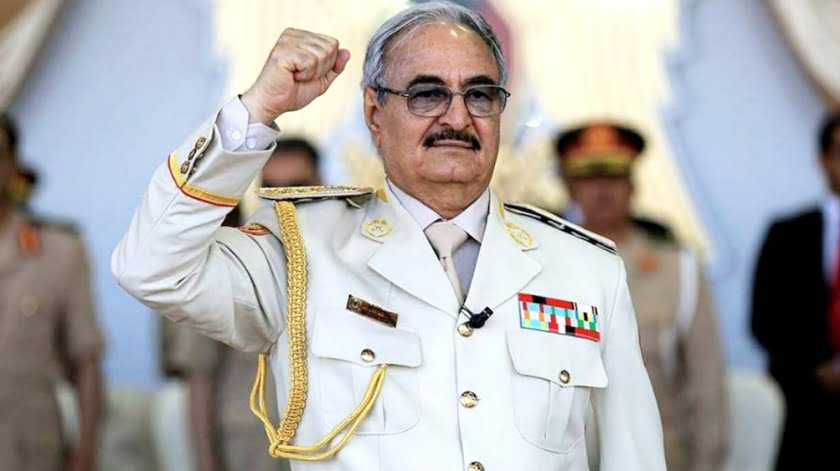Libya’s Civil War, the New Crisis
Besides Syria, the US-inspired ‘Arab Spring’ has resulted in ongoing chaos for Libya, with the oil-rich state still in play, contested between Sarraj’s GNA and Haftar’s Libyan National Army.
Only marginally reported in the west, former Gaddafi lieutenant Haftar suffered a major setback on the 27th of June when the pro-GNA Gharyan Protection Force seized Haftar’s HQ in Gharayan, forcing the LNA to a defensive posture, thus a serious setback for the LNA overall.
Now Haftar’s LNA is busily attempting to re-take its former HQ in Gharayan. Haftar’s setback in Gharayan is just subsequent to Turkey supplying reinforcement weaponry to Sarraj’s GNA, by boat and by air.
Turkey supports the GNA due to its bootleg oil deals in Misrata (offshore oil). Turkey purchases oil at a steep discount from Misrata, when compared to the Libyan National Oil Company’s board prices. The foregoing is especially important to Turkey now, since the United States Treasury ended Turkey’s exemption for Iranian oil purchases.
While Haftar militarily controls much of the east, including the major El Sharara and El Feel oil fields, he is forced to leave production output proceeds to the centralized Libyan National Oil Company. The proceeds of those oil sales still fall to the Tripoli Central Bank, which claims to distribute oil purchase receipts fairly to both sides.
Haftar claims not so, and has thus attempted to setup a rival NOC. He has met with little success. It is believed that Turkey will be forced to pay far higher prices for Haftar’s eastern Libyan NOC oil than it does for bootleg oil received from Misrata rebels, so Turkey has a direct interest in seeing the back of Haftar, and the LNA.
And that is at the heart of the Libyan conflict where Turkey is concerned. Because if Misrata fell to Haftar and the LNA, Turkey would be forced to pay far higher prices for Libyan oil. Meanwhile the GNA is furiously attempting to reinforce its win over Haftar in Cyrenaica.
Unlike Syria where the US has a staunch ally in the YPG, the US has no real political presence in Libya, and only supplies military hardware to both sides. No doubt the Russian Federation sees the power vacuum in Libya as an opportunity, while the United States leadership grandstands elsewhere.
Of course, Libya possesses significant oil reserves and if the Russian Federation can stabilize and support the most powerful faction for a win in Libya, that would certainly be a geopolitical feather in the cap.
While the Russian leadership has backed Haftar to date over Sarraj and the GNA, Haftar is quite an old man and widely distrusted in western Libya. This seven month old article postulates potential Russian support for Saif al Islam in a bid for Libyan power. (see link)
A controversial character, and wanted for trial in Libya and by the ICC, nevertheless Saif al Islam is a charismatic personality, with a large faction – especially in western Libya – willing and ready to support his leadership gambit. Saif al Islam has called for national elections since early 2019, but the elections have been delayed, due to serious clashes between Libyan political factions.
Now with the LNA’s loss of Gharayan, the US-inspired civil war in Libya is likely to rage again. A fascinating and little-reported adjunct to this (ie not reported at all in the major media) is the situation with mercenary pilots, flying and fighting in Libya.
The GNA and LNA both employ mercenary pilots, frequently under bizarre circumstances, even though the basic goal of destroying infrastructure from the air is the same as in any war.
Seldom addressed by the media, Gaddafi’s ‘left behind’ air force consists of many MIG-21’s, MIG-23’s and Mirage F1’s. But since neither Haftar or Sarraj have a real Libyan air force, mercenary pilots are a hot commodity there.
As the Libyan air war heats up, the war planes of the former regime are flown by the aforementioned mercenary pilots, and hired by both sides. These retired pilots were of course trained by various armed forces some years ago, and some do not have adequate recent experience in air combat.
According to Strategika51: “Of two rescued MiG-25’s, one was lost on its test flight by a Mirage pilot unfamiliar with the Mig-25, who stalled at a low altitude. Rumor says that crash related to hostile fire, but nothing in Libya can be confirmed, and everything can be denied.”
For reasons unknown, the western media has been loathe to report on the Soldier of Fortune pilots in Libya, perhaps since that entrepreneurial brief fits so well with the concept of free market warfare.
One exception to that reporting is the case of Jamie Sponaugle, a former USAF pilot, hired by the GNA but shot down in a Mirage F-1 by Haftar’s forces, and lucky to be alive.
The bottom line for Libya is that US-inspired interventionism has led to a complex ever-shifting landscape, a kaleidoscope of alliances and belligerents that affect far more than oil markets or hedge funds.
The struggle for Libya is to find some semblance of national unity, despite the ever-increasing pressure of geopolitical gaming, that must one day spiral out of control.
By Steve Brown
Source: The Duran







